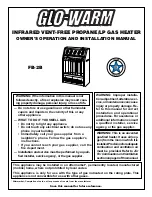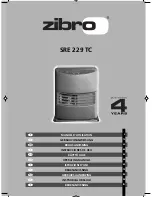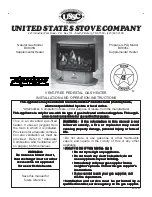
15
PLEASE NOTE: FVI12 IS FOR INDOOR PERMANENT INSTALLATIONS ONLY. THIS MANUAL AND ALL ECCOTEMP CONTENT IS SUBJECT TO CHANGE WITHOUT
NOTICE. PLEASE VISIT WWW.ECCOTEMP.COM/SUPPORT FOR MORE INFORMATION.
Phone: 866-356-1992 | Email: [email protected] | Address: 315 - A Industrial RD Summerville, SC 29483
English
Support:
Eccotemp.com/help-desk
Shop Online:
Eccotemp.com/products
Store Locator:
Eccotemp.com/locator
NOTICE:
Local codes govern the installation of relief valves. If
local codes require that a temperature and pressure relief valve
should be installed the manufacturer recommends a type 40XL
Watts T&P relief valve or an equivalent model be used.
NOTICE:
Manual operation of relief valves should be
performed at least once a year. Turn off the electrical power
and gas shutoff valve. Lift and release lever on the relief valve
and check the manual operation of the relief valve. You should
take precaution to avoid contact with the hot water coming out
of the relief valve and to prevent water damage.
NOTICE:
If the relief valve on the system discharges periodically,
this may be due to thermal expansion in a closed water supply
system. Contact the water supplier or local plumbing inspector
on how to correct this situation. Do not plug the relief valve.
The installation of venting must
comply with national codes, local
codes, and the vent manufacturer’s
instructions. Owner must refer to
vent manufacturer’s instructions and
specifications. Z-Flex information
can be found at www.novaflex.com,
please refer to page 18 for additional
links.
The water heater must be vented to
the outdoors as described in these
instructions. DO NOT connect this
water heater to an existing Vent or
Chimney: it must be vented separately
from all other appliances.
All vent components (adapters, pipe,
elbows, terminals, etc.) should be UL
1738 Certified Stainless Steel Venting
Material (e.g. AL29-4C).
The specified vent termination must
be used. The termination must be
used. The termination should be a
90° elbow type with screen. (Refer to
page 18).
Use a vent pipe with an
antidisconnection structure.
The use of a High Temperature
Silicone (500° F) may be required to
seal vent connections. To prevent
accidental gas exhaust leakage,
apply a ¼” wide bead approximately
¼” from the end and another bead
against the joint side of the stop
bead.
Follow vent manufacturer’s
installation instructions.
The water heater can be vented either
horizontally or vertically.
Vent pipe runs must be adequately
supported along both horizontal and
vertical runs.
The maximum recommended
unsupported span should be no more
than five (5) feet. Support isolation
hanging bands should be used.
DO
NOT
use wire. (See diagram below).
DANGER: Failure
to install the vent
adapter and properly
vent the water heater
to the outdoors as
outlined in the
Venting section of
this manual will result
in unsafe operation
of the water heater
causing death, serious
injury, explosion, or
fire. To avoid the risk
of fire, explosion,or
asphyxiation from
carbon monoxide,
NEVER operate the
water heater unless it
is properly vented
and has adequate
air supply for proper
operation as outlined
in the Venting section
of this manual.
WARNING: Use
UL approved Category
III Stainless Steel vent
material only. No
other vent material
is permitted. Owner
must refer to vent
manufacturer’s
instructions and
specifications. Z-Flex
information can
be found at www.
novaflex.com, see
page 18 for additional
links.
WARNING: Refer
to pages 16-17 for
clearances to
combustible material.
If the vent piping passes through a closed space, wrap the vent pipe with inflammable insulation material
that is at least 3/4” thick. DO NOT let the insulation material make contact with flammable materials. A
minimum clearance of 6” between the vent pipe and ceiling should be maintained. Follow local codes.
For maintenance and inspection purposes, the following holes are
required to be made:
• Two (2) inspection openings that allow access to venting. One
( 1) of these openings should be close to where the vent pipe
enters the ceiling. The other opening should be near the vent
termination.
• A ventilation hole with a 16 sq. in. opening should be made at
least every 10 feet.
NOTICE :
Vent pipes must be completely insulated with
inflammable material when installed in alcoves, closets, and garages and must not touch any flammable
material.
Venting
2 Degree Downward Slope.
Installation
















































